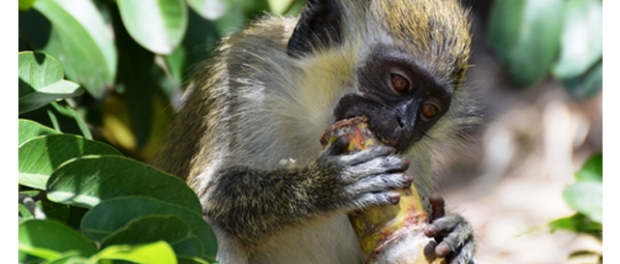Monkey problem: St Kitts‘ great attraction becomes great headache
Get our headlines on WHATSAPP: 1) Save +1 (869) 665-9125 to your contact list. 2) Send a WhatsApp message to that number so we can add you 3) Send your news, photos/videos to times.caribbean@gmail.com

Browse tourist snaps of St Kitts and some of the most photographed faces have olive-brown tresses and piercing hazel eyes which peer inquisitively from trees, private gardens and beach bars alike.
The Caribbean island‘s green vervet monkeys are as iconic as its historic fortresses and black sand beaches.
But the charismatic creatures that so enthral holidaymakers cause misery for local farmers, munching their way through every crop from mangoes and watermelons to squash and cucumber. So indiscriminate are their taste buds, research indicates three in four of the country‘s farms are now affected.
Balancing tourism, which accounts for almost two-thirds of the country‘s GDP, against the need to feed the human population, is a peculiar dichotomy.
Monkeys are not native to St Kitts, or its sister isle Nevis where they also thrive, and were likely brought here by 17th Century early settlers as exotic pets.
Numbers have exploded in recent years since the collapse of the sugar industry which kept them largely confined to the mountains, feeding on cane and culled by rangers.
With fruit trees also lost to hurricanes, the monkeys have gradually made their way down from the hills and into residential areas.
Not only are they believed to now outnumber their human counterparts with estimates of up to 60,000, they routinely outwit them too.
Frustrated farmers‘ attempts to frighten the dexterous simians away from their fruit and veg with scarecrows, rubber snakes and fake birds of prey in mimicry of their natural West African predators are consistently thwarted.
“They soon figure out they‘re not real,” sighs director of environment June Hughes. “I could write a book on how cunning the monkeys are. They test each system and learn very quickly so there‘s no single method that works.
“Some farmers have tried getting dogs which bark at them and send them away. It works for a while and then one day the farmer gets home to find the monkey petting the dog.”
Ms Hughes says the monkeys also ravage indigenous vegetation and wildlife, eating birds‘ eggs and bromeliads.
“When I was a child it was rare to see a monkey. Now they‘re everywhere. Tourists see them and think they‘re so cute. And they are cute but they‘re also a pest,” she explains.
“Still, they are interwoven into our culture. Even most farmers say they don‘t want them gone totally, just off their land and under control..”
Farmer Albert Gordon says his pumpkins are regularly looted by monkeys. “If I see them, I throw a stone and run them off but they come back eventually,” he tells the .
Some islanders have found ways to make a living from the creatures. Local “monkey men” charge tourists $5 (£4) each for a photo with the captivating primates.
Baby monkeys are occasionally seen tied up at city bars to lure in foreign visitors. Sadly, many have been seized from the wild and, when not entertaining holidaymakers, are often kept caged.
Others end up on the dinner table. Colloquially dubbed “tree mutton”, monkey stew is a local delicacy, although not everyone has the stomach for it.
Forest ranger Jourdan Cassius thinks an annual hunting season would help control numbers and provide a cheap source of protein.
Managing the “monkey problem” is a major theme of a new project by the United Nations Environment Programme aimed at tackling invasive species in the Eastern Caribbean.
One initiative planned involves gaining the trust of two troupes of monkeys – one on St Kitts and one on Nevis – from dusk to dawn for an entire year. Those tracking the monkeys will wear the same bright clothes daily so they are easily recognisable by the animals.
The idea behind the project is to enable researchers to get a better understanding of monkeys‘ habits and their impact on local biodiversity, explains its national co-ordinator, biological anthropologist Dr Kerry Dore.
“It might fail but we‘re going to do our best,” she says. “We‘ll start by talking to villagers who know the monkeys‘ schedules and asking where they usually see them.”
Researchers will also meet hoteliers, monkey men, farmers and families to thoroughly assess the animals‘ environmental and economic impact, and place cameras in birds‘ nests to verify if monkeys are indeed stealing eggs.
Ultimately, the aim is to gather information to help guide policy-makers.
Mass sterilisation of monkeys, while more “tourist-friendly” than a mass cull as some suggest, poses practical and financial challenges.
“This isn‘t like dealing with an overpopulation of rats,” Dr Dore adds. “Monkeys are the most sentient and intelligent of the animal kingdom.”
Dr Christa Gallagher, a lecturer at Ross University School of Veterinary Medicine in Basseterre, has been studying St Kitts‘ monkeys for years. Her work has involved fitting them with GPS collars to gauge their range and interface with humans.
“They‘re absolutely fascinating. They study us as much as we watch them,” she says. “To see their social interactions and the mother-baby bond is incredible.”
Dr Gallagher thinks replanting lost fruit trees could help encourage them back into the mountains.
“Monkeys represent amazing biodiversity, they‘re a natural resource and need to be protected,” she says, adding: “Human-animal conflicts exist all over the world. We need to find a way to co-exist harmoniously.”
Leave a comment
You must be logged in to post a comment.